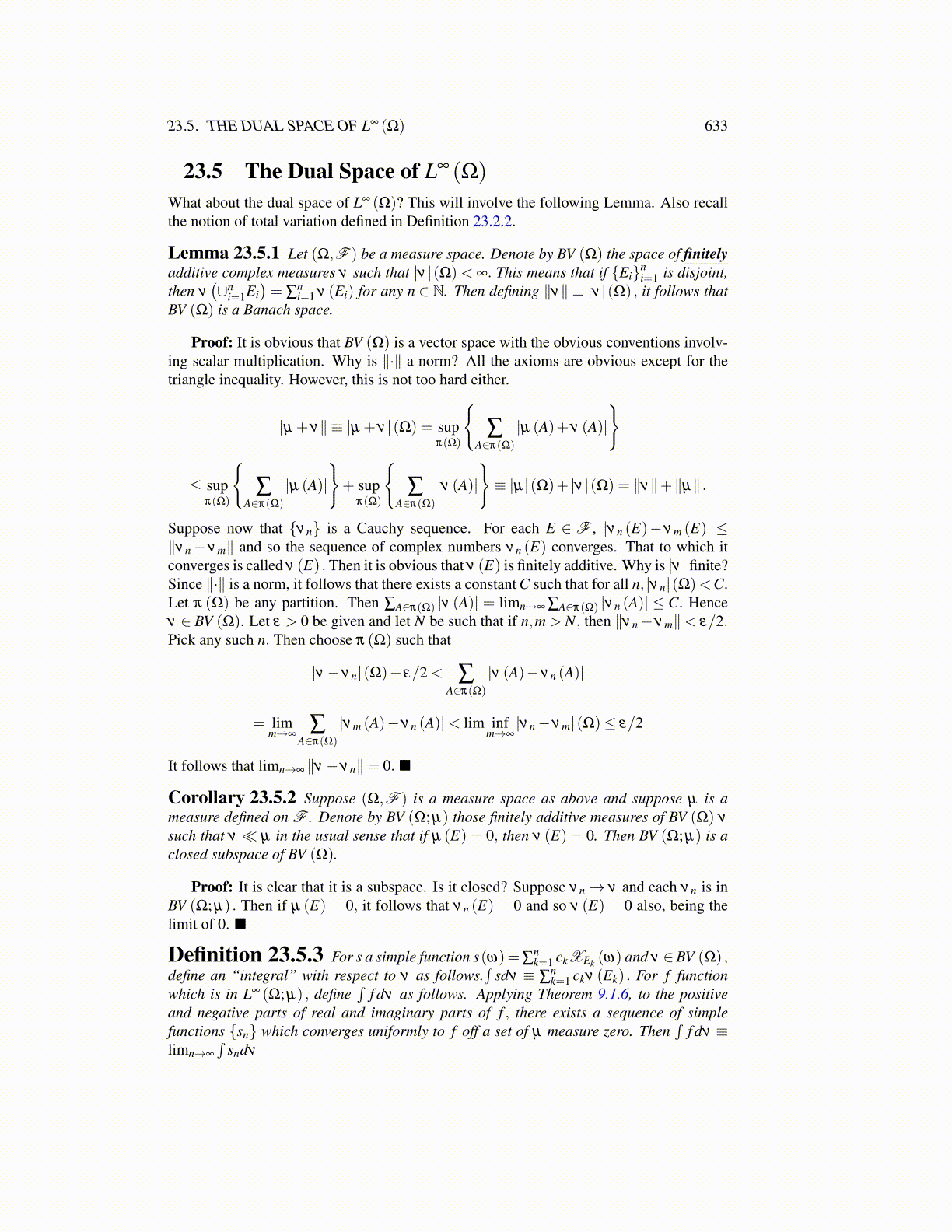
23.5. THE DUAL SPACE OF L∞ (Ω) 633
23.5 The Dual Space of L∞ (Ω)
What about the dual space of L∞ (Ω)? This will involve the following Lemma. Also recallthe notion of total variation defined in Definition 23.2.2.
Lemma 23.5.1 Let (Ω,F ) be a measure space. Denote by BV (Ω) the space of finitelyadditive complex measures ν such that |ν |(Ω)< ∞. This means that if {Ei}n
i=1 is disjoint,then ν
(∪n
i=1Ei)= ∑
ni=1 ν (Ei) for any n ∈ N. Then defining ∥ν∥ ≡ |ν |(Ω) , it follows that
BV (Ω) is a Banach space.
Proof: It is obvious that BV (Ω) is a vector space with the obvious conventions involv-ing scalar multiplication. Why is ∥·∥ a norm? All the axioms are obvious except for thetriangle inequality. However, this is not too hard either.
∥µ +ν∥ ≡ |µ +ν |(Ω) = supπ(Ω)
{∑
A∈π(Ω)
|µ (A)+ν (A)|}
≤ supπ(Ω)
{∑
A∈π(Ω)
|µ (A)|}+ sup
π(Ω)
{∑
A∈π(Ω)
|ν (A)|}≡ |µ|(Ω)+ |ν |(Ω) = ∥ν∥+∥µ∥ .
Suppose now that {νn} is a Cauchy sequence. For each E ∈ F , |νn (E)−νm (E)| ≤∥νn−νm∥ and so the sequence of complex numbers νn (E) converges. That to which itconverges is called ν (E) . Then it is obvious that ν (E) is finitely additive. Why is |ν | finite?Since ∥·∥ is a norm, it follows that there exists a constant C such that for all n, |νn|(Ω)<C.Let π (Ω) be any partition. Then ∑A∈π(Ω) |ν (A)| = limn→∞ ∑A∈π(Ω) |νn (A)| ≤ C. Henceν ∈ BV (Ω). Let ε > 0 be given and let N be such that if n,m > N, then ∥νn−νm∥< ε/2.Pick any such n. Then choose π (Ω) such that
|ν−νn|(Ω)− ε/2 < ∑A∈π(Ω)
|ν (A)−νn (A)|
= limm→∞
∑A∈π(Ω)
|νm (A)−νn (A)|< lim infm→∞|νn−νm|(Ω)≤ ε/2
It follows that limn→∞ ∥ν−νn∥= 0. ■
Corollary 23.5.2 Suppose (Ω,F ) is a measure space as above and suppose µ is ameasure defined on F . Denote by BV (Ω; µ) those finitely additive measures of BV (Ω) ν
such that ν ≪ µ in the usual sense that if µ (E) = 0, then ν (E) = 0. Then BV (Ω; µ) is aclosed subspace of BV (Ω).
Proof: It is clear that it is a subspace. Is it closed? Suppose νn→ ν and each νn is inBV (Ω; µ) . Then if µ (E) = 0, it follows that νn (E) = 0 and so ν (E) = 0 also, being thelimit of 0. ■
Definition 23.5.3 For s a simple function s(ω)=∑nk=1 ckXEk (ω) and ν ∈BV (Ω) ,
define an “integral” with respect to ν as follows.∫
sdν ≡ ∑nk=1 ckν (Ek) . For f function
which is in L∞ (Ω; µ) , define∫
f dν as follows. Applying Theorem 9.1.6, to the positiveand negative parts of real and imaginary parts of f , there exists a sequence of simplefunctions {sn} which converges uniformly to f off a set of µ measure zero. Then
∫f dν ≡
limn→∞
∫sndν